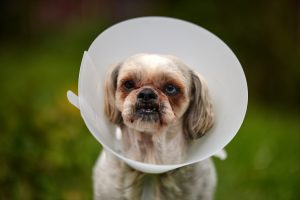Options for Safe Exercise and Fun After Your Dog Has Surgery
Options for Safe Exercise and Fun After Your Dog Has Surgery

After your dog’s surgery, they will need plenty of rest and physical restriction for recovery to be a success. This may mean they will be crated or otherwise immobilized during those crucial few weeks after an operation. Gradually, your pet will need to move and get some level of physical exercise as they build strength and stamina.
If your pet is about to have or has recently had a surgery, you may wonder what options there are for exercise and entertainment. The team at Parkside Animal Hospital is here with some tips and recommendations for getting your bestie back on track after your dog has surgery.
The Rules of Recovery
Doctor’s orders are a must to follow after any medical procedure, and this is the case with your veterinarian’s instructions for your patient. It is important to follow these instructions by the letter to avoid creating pain, causing an injury, or otherwise setting the recovery back by doing too much too soon. Most soft tissue surgeries can expect a 2-3 week timeframe of rest and recuperation, while more complex surgeries like a ligament repair will take weeks, sometimes months to recovery from.
The key thing to note is that, even though it may be hard, keeping your pet rested is incredibly important to their swift and successful recovery. If you have any questions about your pet’s needs or what to expect, please contact us.
Safely Exercising Your Pet Patient
Most surgeries usually allow your pet to walk outside to potty or use the litter box during the first 24 hours. Your pet will be groggy, so you may need to aid them in walking slowly or carrying them to the backyard. They can also get up to stretch and change positions, so their crate or pen need to be spacious enough for them to do so.
Once you get the green light for exercise or movement, offer your pet a short, slow walk around the yard on a leash. These short intervals will give your pet fresh air, as well as allow them to move about in a controlled manner. Over the next few weeks, add a few minutes more to your pet’s daily walk, building up over time to their normal walking routine.
Do not allow your dog to run, jump, or engage in rigorous activity for the first two-three weeks, or when it is deemed safe by your veterinarian.
Many pets advance in their recovery through the use of passive range of motion exercises, such as sitting and rising, lying down and getting up, circles and counterclockwise circles, walking up ramps and back down, and so on. Swimming in a wam pool and walking on a treadmill on a leash are also great low impact forms of exercise once sutures have fully healed.
Ideas for Entertainment
Along with exercise, your dog will need mental enrichment in the form of games and toys. Make sure that even these do not require running or jumping. A few ideas for fun include:
Kong toy filled with peanut butter
- Dental chews
- Feeding games
- Nylabone
- Stuffed toys
- Tug of war
- Animal videos or shows like Animal Planet
- Window view of the outside (pets love to watch birds, squirrels, etc.)
- Brushing your pet can be soothing
- Touch training (they can lay down and move only their head if the post-op care requires it).
Make sure that your pet has plenty of things to do and new toys to alleviate boredom and encourage a happier pet.
When Your Dog Has Surgery
There is a lot to consider after your four-legged friend has surgery, and good postoperative care includes healthy diet, enrichment, rest, and low impact exercise, along with medications and follow up veterinary exams. If you have any questions about what to do when your dog has surgery and how to safely start them moving again, please contact us.
